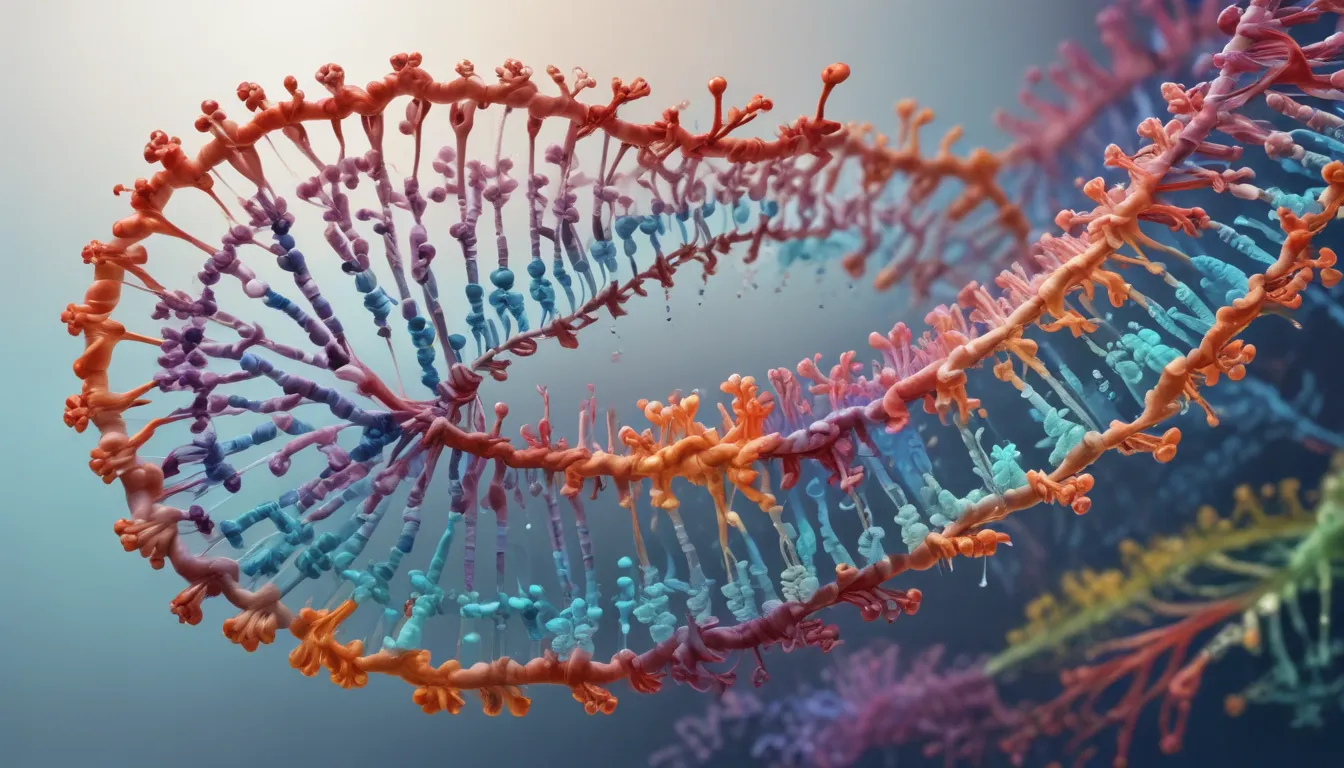A Note About Images: The images used in our articles are for illustration purposes only and may not exactly match the content. They are meant to engage readers, but the text should be relied upon for accurate information.
MicroRNAs, or miRNAs, are tiny yet powerful molecules that play a crucial role in gene regulation across various organisms. Discovered in the early 1990s, these small RNA molecules, typically made up of about 22 nucleotides, have captured the attention of researchers in the field of molecular biology. Their ability to influence gene expression by binding to messenger RNA (mRNA) molecules and either inhibiting their translation or causing their degradation has profound implications for biological processes, including development, cell growth, metabolism, and diseases like cancer.
In this comprehensive guide, we will delve into 14 surprising facts about miRNAs, shedding light on their diverse functions, mechanisms of action, and potential applications in diagnostics and therapeutics. Get ready to embark on a journey through the fascinating world of miRNAs!
Unraveling the Mysteries of MicroRNA (miRNA)
- MiRNA, the Tiny Superhero:
-
MiRNA, or MicroRNA, acts as a miniature superhero inside our bodies, controlling genes and playing various roles in our health, from development to disease.
-
Unlocking the Treasure Trove:
- Scientists have identified over 1,000 unique MicroRNA sequences in different species, highlighting the essential nature of these tiny molecules in life and their potential for novel treatments.
The Enigmatic MicroRNA (miRNA) Unveiled
MiRNA: The Tiny Regulator
MicroRNA, commonly known as miRNA, is a small RNA molecule composed of around 22 nucleotides that plays a pivotal role in regulating gene expression.
Diverse Functions of miRNAs
MiRNAs are integral to various biological processes, including development, cell differentiation, apoptosis, and immune response. They have the ability to regulate the expression of thousands of genes.
Evolutionary Discovery of miRNAs
The discovery of miRNAs dates back to 1993 when a small RNA molecule associated with developmental timing was identified in the roundworm Caenorhabditis elegans.
The Abundance of miRNAs
Scientists have uncovered thousands of unique miRNA sequences across different species, demonstrating the broad regulatory potential of these molecules on messenger RNAs (mRNAs).
Conserved Role of miRNAs
MiRNAs exhibit a high degree of conservation among species, indicating their fundamental role in biological processes. This conservation underscores their functional importance throughout the evolutionary process.
MiRNAs in Disease Regulation
Several miRNAs have been found to act as tumor suppressors by inhibiting tumor growth through the suppression of oncogenes or genes involved in cell proliferation. This highlights their potential in cancer therapeutics.
Role of miRNAs in Neurodegenerative Diseases
Malfunctioning miRNA expression has been linked to various neurodegenerative conditions, such as Alzheimer’s disease, Parkinson’s disease, and Huntington’s disease. Understanding the involvement of miRNAs in these diseases paves the way for novel therapeutic approaches.
Detecting miRNAs in Body Fluids
MiRNAs display stability in body fluids like blood, saliva, and urine, making them promising non-invasive biomarkers for diagnosing and prognosing a range of diseases.
Immunomodulatory Functions of miRNAs
A multitude of miRNAs have been identified to modulate immune responses by regulating gene expression in immune cell differentiation, activation, and cytokine production.
Therapeutic Potential of miRNAs
The regulatory role of miRNAs in gene expression renders them attractive targets for therapeutic interventions. Researchers are actively exploring miRNA-based therapies for various conditions, including cancer.
Forensic Application of miRNAs
Due to their stability and abundance, miRNAs have found practical use in forensic investigations for human identification and detecting body fluids at crime scenes.
Developmental Role of miRNAs
MiRNAs play a critical part in embryonic development by controlling the expression of genes involved in cell fate determination, tissue patterning, and organ formation.
Influence on Metabolic Processes
Certain miRNAs regulate metabolic pathways like lipid metabolism, glucose homeostasis, and energy balance. An imbalance in miRNA expression can contribute to metabolic disorders.
Essential Role in Plant Development
MiRNAs play a vital function in plant growth and development by regulating genes associated with root development, leaf morphology, flowering, and stress responses.
These captivating facts about MicroRNA (miRNA) underscore the significance of this small RNA molecule across a spectrum of biological processes. From gene regulation to potential therapeutic targets, miRNA research continues to unravel new insights into its functionalities and potential applications. As scientists delve deeper into the complexities of miRNAs, they open doors to promising possibilities for future discoveries and advancements in the field.
Delving Deeper into the World of MicroRNA (miRNA)
MicroRNAs, also known as microRNAs, represent an intriguing element of the vast biological landscape. These minute molecules play a crucial role in various biological processes, echoing throughout gene regulation, development, and disease. Through their intricate interactions with messenger RNA, miRNAs can shape protein synthesis and impact the functioning of living entities.
Throughout this exploration, we have unearthed 14 astonishing facts about miRNAs. From their origins in the early 1990s to their potential roles in diagnostics and therapeutics, miRNAs continue to captivate the scientific community worldwide. They signify a new avenue for understanding the intricacies of cellular processes and unraveling the mechanisms underpinning diverse diseases.
As our comprehension of miRNAs evolves, their profound impact on living organisms’ functionality becomes more palpable. Their intricate involvement in gene regulation and disease renders them a captivating subject of study with immense potential for future research and medical breakthroughs.
Frequently Asked Questions
1. What are miRNAs?
- MiRNAs, short for microRNAs, are small RNA molecules that play a crucial role in gene regulation. By binding to messenger RNA, they can inhibit protein production, affecting diverse biological processes.
2. How were miRNAs discovered?
- MiRNAs were first uncovered in the early 1990s when researchers noticed small RNA molecules that did not appear to code for proteins. Further investigations revealed their capacity to regulate gene expression.
3. What is the function of miRNAs?
- Primarily, miRNAs function in post-transcriptional gene regulation by binding to messenger RNA molecules. This binding can trigger mRNA degradation or impede its translation into proteins.
4. How many miRNAs exist?
- It is estimated that most organisms, including humans, harbor thousands of miRNAs. Each miRNA molecule has the potential to target multiple messenger RNA molecules.
5. Are miRNAs involved in disease?
- Yes, miRNAs have been implicated in various diseases such as cancer, cardiovascular disease, and neurodegenerative disorders. Dysregulation of miRNA expression can contribute to disease progression.
6. Can miRNAs be used for diagnostic purposes?
- Certainly, the distinct miRNA expression patterns in different diseases make them prospective biomarkers for diagnostics. Researchers are exploring miRNAs as non-invasive markers for early disease detection.
7. Are miRNAs being investigated for therapeutic applications?
- Absolutely, miRNA-based therapeutics are actively under investigation. Researchers are exploring the use of synthetic miRNA molecules to target specific genes and potentially treat a wide array of diseases.
Embarking on a Journey Through RNA’s Intricate World
Exploring the realm of microRNAs unveils just the tip of the iceberg in understanding the intricate roles of RNA in biology. It leads to unraveling the mysteries of RNA interference, a potent tool for gene silencing. It delves into the enigmatic realm of non-coding RNA, once disregarded as “junk” but now recognized as pivotal regulators. It shines a light on the intricate networks of molecules orchestrating gene regulation, shaping the development and function of organisms.
Conclusion: Embracing the Complexity of MicroRNA (miRNA)
MicroRNAs, or miRNAs, epitomize a captivating aspect of the intricate world of biology. These tiny molecules wield immense power, impacting gene regulation, development, and diseases. Through their capacity to bind to messenger RNA, miRNAs stand as pivotal players in shaping protein synthesis and biological functions.
Within this discourse, we have unveiled 14 astonishing facts about miRNAs, ranging from their humble origins in the early 1990s to their promising roles in diagnostics and therapeutics. MiRNAs continue to enchant researchers globally, offering a fresh perspective on cellular intricacies and disease mechanisms.
As our knowledge of miRNAs deepens, their profound influence on living organisms’ functions becomes increasingly evident. Their intricate involvement in gene regulation and disease positions them as a fascinating subject of study, brimming with potential for future research endeavors and medical progress.
Were You Enlightened by Our Exploration?
At the core of our mission lies the commitment to delivering reliable, engaging content that resonates with our audience. Each fact we present is a product of real users like you, contributing a wealth of diverse insights and information. Our dedicated team of editors rigorously reviews each submission to ensure the highest standards of accuracy and credibility. Trust in our dedication to quality and authenticity as you delve into the realm of discovery and learning with us.






